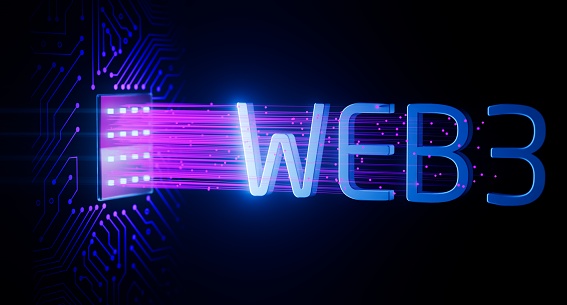Even though there are still important problems to solve before the blockchain-based future of the internet can be built, you need to start dipping your toes in it now.
So, before you go buy that digital Gucci handbag in Roblox or set up your virtual office headquarters in Decentraland (like the Barbados embassy just did), I’d like to fill you in on what I think are some of the most important problems that Web 3.0 will have to deal with in the future. I’ll explain what needs to be done to fix them and what you can start doing right now to give your business an edge when the “future of the internet” arrives in all its glory.
People usually believe the hype. Most people don’t like things they don’t fully understand. Most people won’t learn something new unless it’s right in front of them and they can’t avoid it. Don’t be like that.
What Web 3.0 has to deal with
Most of the people who are behind the recent Web3 hype cycle just want to make a quick buck. If, on the other hand, you want to take part in a more long-term and strategic way, I’d suggest you first learn about the problems facing the infrastructure that the new virtual world is built on. Even though I think Web 3.0 will happen, I think it will take at least 5–10 years to get there. There are many problems with blockchain technology, such as its cost-effectiveness, scalability, accessibility, and user experience. Because of these problems, mass adoption is unlikely to happen in the short to medium term.
Cost
When the blockchain was first thought of, one of its main benefits was that transactions would be free. After only a few years, blockchain technology is turning out to be very expensive and hard to run.
Governments are starting to worry. China, which used to be a major centre for crypto mining, has gone to great lengths to limit crypto operations by making crypto mining illegal. Concerns about energy are making many other countries do the same, such as Sweden, Russia, Kosovo, Iceland, and Kazakhstan. Still, it is encouraging to see a serious shift toward using natural gas, hydroelectric, wind, and solar projects to power cryptocurrency mining. Even on a smaller scale, there is a lot of new stuff going on. Most decentralised apps only put a small amount of code on the blockchain itself to avoid the high transaction costs, and I’m seeing more startups work on other ways to make money off of the network to make up for these costs. Even though a lot of progress is being made to make this technology more affordable, I’d say that cost is still a big problem that needs to be solved soon.
Scalability
In a decentralised network, transactions take longer because every transaction or change in state that needs to be processed needs to be sent through the whole peer-to-peer network. This takes a huge amount of computing power, and transactions that were meant to be almost instantaneous often take a long time to process or have to pay very high “gas fees” to speed up. For those who don’t know, “gas fees” are payments made by users to pay for the computing power needed to process and validate transactions on the Ethereum blockchain. So transactions that were supposed to be “free” can end up costing a lot.
Another reason to worry is that Intel, the biggest maker of microchips, says that even though we’ll have 5–10 times the computing power we have now in the next five years, we’ll need 1000 times that power to make web3 consulting company and, eventually, the metaverse a reality. I’m seeing more and more projects use off-chain transactions to improve processing times and get around the scalability problem. They then put the completed transactions back on the blockchain, but these “solutions” have their own problems, such as problems with consensus and governance. So, even though software is changing faster than ever before, there is still a huge gap between the software and the hardware. The hardware is several orders of magnitude behind the software.
User experience
We all like to use interfaces that are easy to figure out. This is one reason why we love using Airbnb’s website to book vacation rentals. We love getting rides with the Uber app because of this. But if you’ve tried to do anything on the blockchain or interact in Web3, you already know that there’s a very steep learning curve. Your current web browsers won’t let you get to Web3 experiences directly. For your Ethereum, you need a MetaMask wallet. For your Solana, you need a Phantom wallet. You have to add a lot of extensions or plug-ins to your browser just to get the most basic features, which is very complicated compared to the simple web browsers we’re used to. For Web3 to be used by a lot of people, it will have to be a lot easier to get to and move around. And a lot of people will need information and training on how to get started.
Accessibility
Accessibility is the last big problem I see with Web 3.0 coming to life. Elon Musk’s Starlink is still trying to figure out how to bring Web 1.0 and Web 2.0 to many parts of the developing world. In addition to reach, we will need to upgrade the hardware of both servers and end-user devices on a large scale because mobile and IoT devices are not ready for the Web3 revolution.
Even so, if you think about it, we’re moving at a very fast rate. It took more than 50 years for cars to be used by most people, and the internet took about half that long. Even though it won’t take as long, we still have a long way to go before we have an open and permissionless web.
What you can do now to get your business ready for the future
Now that you know a full-fledged Web3 won’t be here for a few years, what’s the best thing you can do now to get ahead of the curve? Start with just three easy steps.
Learn something.
How much do you really know about the things that make Web3 work? What programmes or projects are you keeping an eye on? Do you have a place where you can learn about the changes in your industry? To get started, you should think about how you want to position your brand as a Web 3 player in the long run, so you don’t have to play catch-up. Set up Google Alerts and put “Web3” as a keyword to keep track of. Once you’ve done that, you’ll get an email every day with a summary of what’s important in the space.
Learn about the pioneers
Brands that want to be the first to use Web3 and the metaverse have already started making their bets. Nike and Adidas come to mind. Think Pepsi. Consider Zara. Think Snoop Dogg. Yes, Snoop Dogg. From them, what can you learn? What projects will they pick? How do they set themselves up? How well did their ICOs or NFTs do when they came out? What are they trying to fix? How have they changed the way they do business? Why did they mess up? You’ll be able to move faster if you learn from their mistakes as well as your own.
Start small
As business payments and transactions become decentralised, Web3 will change the future of business finance. I’m going to assume that the word “DeFi” has been thrown at you recently. You’ll need to know about decentralised finance, or DeFi, if you want to stay relevant in Web3 and send and receive payments. But that doesn’t mean you can’t begin with something small. For example, one of the easiest ways to get started right now is to set up your wallet and buy a Web3 domain that you can use to start your Web 2.0 and Web 3.0 experiences. Just think about how hard it is right now to find a simple.com domain. Soon enough, the same thing will happen with Web3 domains. The other benefit is that you will own your Web3 domain. Instead of renting your domain name from GoDaddy or Google, as most of us do now, you will own it.
I suggest that you buy your domain through the Ethereum Name Service (ENS). From there, you can link it to your wallet address so that your transactions and identity can be tied back to you. You can then give customers an easier way to pay you instead of sending them your wallet’s hex address, which is ridiculously long and easy to mix up. You don’t have to go all out. Just try to learn a little more about Web3’s core ideas every day so you’re ready to switch when the time comes.


Comments are closed.